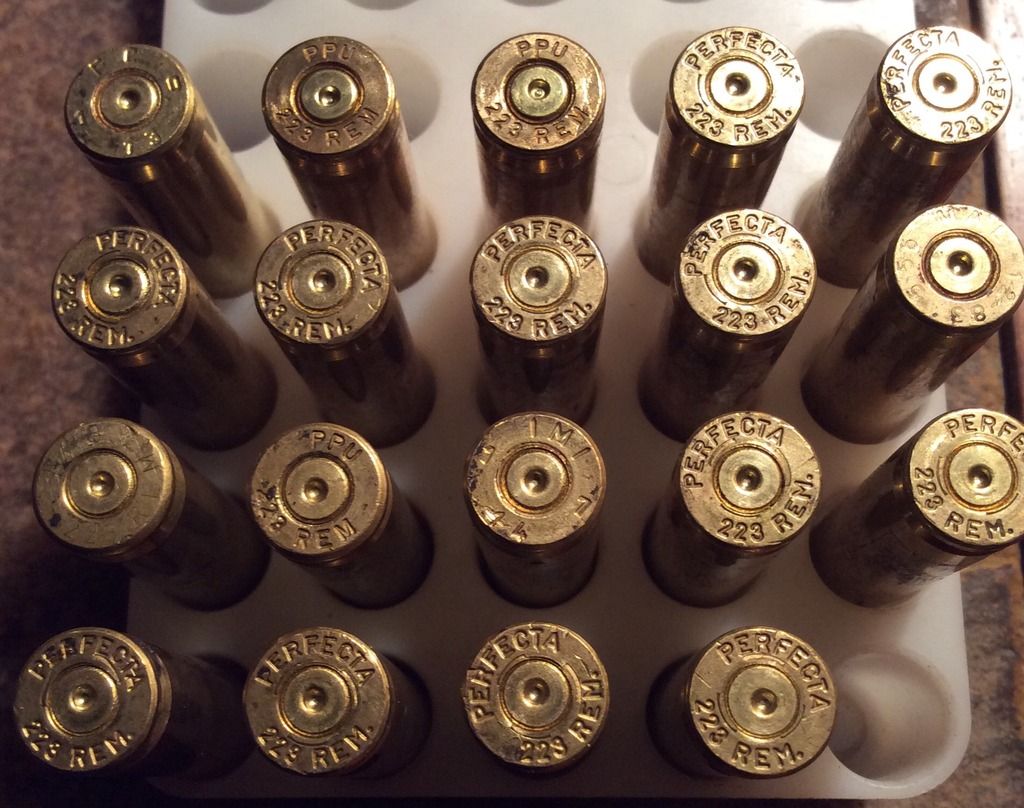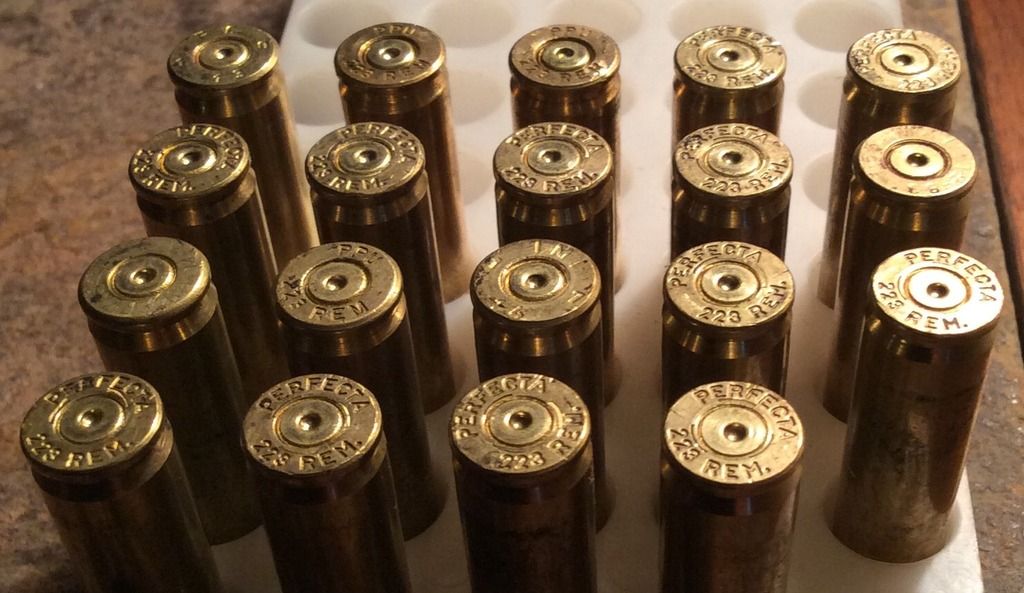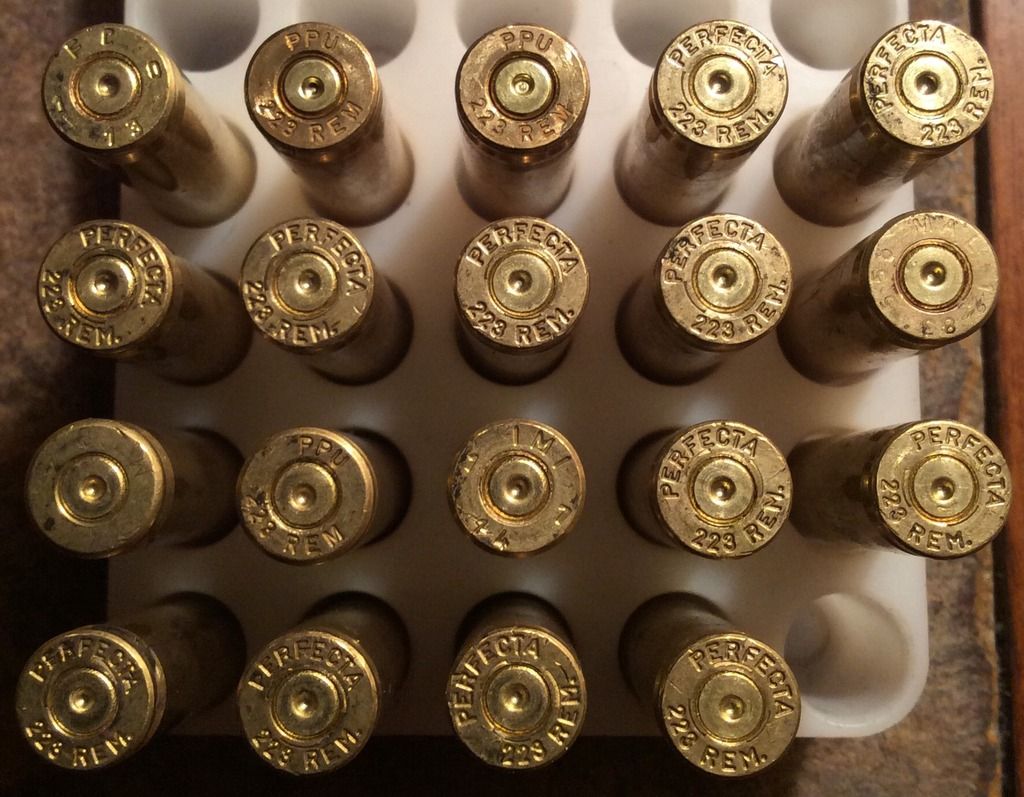

 The Accurate Reloading Forums
The Accurate Reloading Forums  THE ACCURATE RELOADING.COM FORUMS
THE ACCURATE RELOADING.COM FORUMS  Guns, Politics, Gunsmithing & Reloading
Guns, Politics, Gunsmithing & Reloading  Reloading
Reloading  .223 Pressure Signs?
.223 Pressure Signs?Go  | New  | Find  | Notify  | Tools  | Reply  |  |
| One of Us |
Finally loaded up some .223 rounds over the weekend and went to the range. Loaded up 20 to test as there is no load data for exactly what components I'm using. After retrieving 19 of the 20, some of them have flattened primers and some don"t which is odd because these are no where near max and my powder measure is fairly consistent. Here's what I'm using: Mixed headstamp range pickup brass CCI No. 41 primers Hodgdon CFE 223 powder Hornady 55gr FMJ bullets Hodgdon only lists two loads for a 55gr bullet: Barnes TSX FB - Start: 24.7 Max: 27.4 Speer SP - Start: 26.0 Max: 27.8 They"re also using Winchester small rifle primers. I set my powder measure to throw what I though would be a good conservative starting load at roughly 25.5gr. I threw ten charges, weighed each one and got: 25.8 25.8 25.8 25.7 25.6 25.7 25.6 25.6 25.8 25.5 So, from lightest to heaviest it varies .3gr and falls between the starting load for the two listings from Hodgdon. The cases were all full length resized, checked with a Wilson case gage, and trimmed to 1.750. The OAL is 2.230, the bullets measure .740 and seating depth is .260. I'm using Lee dies with the factory crimp die. Some primers are flattened, some are fine, none are cratered. It doesn't make any sense assuming the heaviest charge thrown would have been 25.8 and that's still below the starting load for the Speer bullet and well below max. The only other variable I can think of is I was gentle on the factory crimp step and maybe that's heavy on some and light on others. I'm considering trying to get closer to 25.0 with this double disk kit and try 20 more at that weight.    How do these cases look to everyone else? | ||
|
| one of us |
Mixing various brands of brass will cause you more issues that the slight variance in powder charge. The perfecta is showing most of the flat primers. Smaller case volume or looser pockets? As usual just my $.02 Paul K | |||
|
| One of Us |
What rifle are you using? I've never crimped a .223 cartridge. But I've only used bolt rifles, never any sort of AR so I don't know if a crimp in needed in a auto or not. I'm gonna agree that variance in capacity may be your culprit. Aim for the exit hole | |||
|
| One of Us |
Looks like like you are near max in one brand of brass, and over in the other. I have run into this with my 7mm-08. Loads using winchester brass showed no signs of pressure. One piece of Fed brass got into the mix and the bolt was sticky on opening. I recommend sorting your brass or reducing the charge by 10% "though the will of the majority is in all cases to prevail, that will to be rightful must be reasonable; that the minority possess their equal rights, which equal law must protect, and to violate would be oppression." ---Thomas Jefferson | |||
|
| One of Us |
These are being shot out of an AR w/ a Colt M16A1 upper. | |||
|
| One of Us |
All your primers look fine but the last one and it isn't bad. I would continue to march. | |||
|
| one of us |
The "flatness" of the primer is MUCH MORE related to how much headspace a particular round has than to how much pressure it generates. What you are seeing is a result of some of the cases being shorter in the head-to-shoulder dimension than others. When the rifle is fired the firing pin pushes the case to the extreme forward position, that is, it is pushed forward until its shoulder bears against the corresponding shoulder of the chamber. Upon ignition the primer backs out of the primer pocket slightly until it is firmly against the bolt face, then the internal case pressure pushes the head of the case rearward until it rests against the bolt face. The result is that the greater the space betwen the bolt face and the case head, the more the primer spreads against the bolt face, thus appears more "flattened". A relatively high pressure load will leave rounded primer edges if the case is a crush fit in the chamber, whereas a relatively low pressure load will leave very flat primers, even spread well into the bevel of the primer pocket, if the round is somewhat loose in the chamber. The ONLY time that the appearance of primer flattening will give some indication of pressure is when the cases and primers are identical and the case is at or near a crush fit in the chamber. Otherwise, the appearance of the primer (absent a pierce or an annular blowout) tells you next to nothing. | |||
|
| one of us |
Flat primers can or cannot be a sign of pressure, depends on the hardness of the primer metal in many cases, its a myth of sorts, but combine flat primers with other signs of pressure and its accurate..I do not see any sign of excessive pressure in the primers you display and I didn't see an extractor mark on any case displayed, which would normally show up with hotter loads, at least on some of the cases.. I would go back and start with the most accurate load of that batch and fire and reload, that most accurate load, over and over again and see how many handloads I would get out of one case before primers got loose..Its a lot of trouble but when done, you know what you have..I would expect at least 10 reloads from a case and probably 14, and two or three trims from a case in that 14.. Don't mix brass, it can ruin any testing you can do..If one must mix brass then shoot starting loads, but accuracy sometimes suffers when brass, primers or powder charges are mixed.Any change may change POI and/or accuracy. consistency is the key to accuracy as a rule, but nothing in reloading is written in stone as their are so many conflicts to deal with. The above may vari with an auto loader, I don't know, as I have only shot factory ammo in the auto loading 223s. Ray Atkinson Atkinson Hunting Adventures 10 Ward Lane, Filer, Idaho, 83328 208-731-4120 rayatkinsonhunting@gmail.com | |||
|
| One of Us |
thanks everyone for your thoughts. I've got some Lake City brass I'm going to load up and see what happens to the primers. I don't really want to work up loads for every brand of brass I've picked up, so I may just give aay all my range pick ups anf stick with Lake City brass. I can get once fired for $50 - $60 per 1000. | |||
|
| One of Us |
Those all look below max I'll take a picture of some brass from my p-dog rifle that's at max+p ________________________________________________ Maker of The Frankenstud Sling Keeper Proudly made in the USA Acepting all forms of payment | |||
|
| One of Us |
I looked for ejector hole marks and scour from that before considering primers for pressure issues-didn't see any from your pics. The AR can be funny with brass, so keep your recipe within constraints and look for obvious signs, like torn rims, head expansion, loose primer pockets. Your rifle likely has a 556 nato spec chamber, so it is deeper and more spacious than a 223 rm commercial chamber, so that can soak up pressure at brass expansion cost. I doubt you are approaching let alone exceeding the 556 spec of 63k psi. Range pick up brass? A rather serious no-no. Many leave their brass in final throes on the ground-as trash. ( on a High power range, never pick anyone else's 223/556 brass-espc at the 600 yd line!) Use known quality brass-your face/eyes may depend on it! | |||
|
| One of Us |
5.56 NATO chambers are not bigger than the .223 Rem Freebore.....longer jump to the lands in a 5.56 than a .223Rem.....that's it!! and yes...it is just that simple Don't use range brass? Funny....I will always use it Really easy to tell 1x fired 5.56 brass and the lions share of .223..... primmer crimp ________________________________________________ Maker of The Frankenstud Sling Keeper Proudly made in the USA Acepting all forms of payment | |||
|
| One of Us |
What Ted said; you have no problem; continue to load and shoot. "Serious no-no"?; please. Too dramatic a statement. I have managed for well over 50 years using any brass I can get, wherever I can find it, without issues. | |||
|
| one of us |
Darn been loading for 40+ years. Don't remember picking up and using rifle brass. Have picked up sorted and used various handgun brass. Lighter target loads. As to 223 brass with the availability of once fired sorted 223 brass why bother? As Ted said crimped is easy to see. If I did feel I needed to pickup 223 I would at the very least sort it. Are some of your loads over pressure anyone can guess. Is there a difference between brands in my opinion yes. As usual just my $.02 Paul K | |||
|
| One of Us |
Well, loaded up 40 more rounds over the weekend. Same bullet, primer, and powder as before but I used only Lake City brass. Used four different charges from 25 grains to just over 26 grains. Not one case showed any flattened primers. The most accurate loads surprisingly were the two lightest. | |||
|
| one of us |
If anything, I would check the length of the firing pin, the indentions seem very deep in the pictures..I can't see that your even near max on any of the fired cases in the pictures. Ray Atkinson Atkinson Hunting Adventures 10 Ward Lane, Filer, Idaho, 83328 208-731-4120 rayatkinsonhunting@gmail.com | |||
|
| One of Us |
Below are the results of Quickload on .223/5.56 cases and the case capacity in grains of H2O. The case below is military Lake City with the MOST case capacity at 30.6 grains of H2O and using 25 grains of H335 with a 55 grain Hornady FMJ  Below is a military IMI 5.56 case with 28.0 grains of case capacity with the same load "AND" 6,000 psi higher chamber pressure.  Bottom line, I do not use mixed brass and primarily use Lake City brass in my AR15 rifles. Lake City brass is very high quality and has the hardest brass in the base than any other commercial case made. Meaning these cases were designed and matched to the military M16 rifles chamber.    | |||
|
| One of Us |
Wow, thanks for taking the time to run that data and post it. I have to admit, I don't understand the physics of why one .223 case would generate higher pressures than another with an identical load. I do plan to use only Lake City brass in my AR though. It's plentiful, cheap, and known to be high quality, so I'll just keep things simple since I already have a load worked up. | |||
|
| Powered by Social Strata |
| Please Wait. Your request is being processed... |
|

Visit our on-line store for AR Memorabilia

